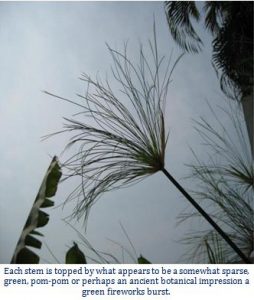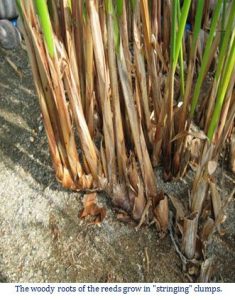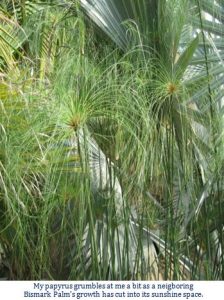By Tommy Clarkson from the January 2016 Edition
Family: Cyperaceae
Also known as Papyrus, Giant Papyrus or Paper Reed
Before discussing the Cyperus papyrus, let’s talk a bit about the Cyperus family whole which consists of around 600 herbaceous sedge, water loving species. They range from the tropics to rather high latitude temperate areas, primarily, in Asia and Africa. Some are employed as pasture plants while many other are merely considered weeds.
The two most well-known of the lot are the Umbrella Plant from Madagascar and our featured fellow, the Papyrus. Both, I have found while conducting tours or Ola Brisa Gardens – seem to be particular favorites of many and are gleefully recognized by many of our visitors.
Papyrus is now nearly extinct in its native habitat in the Nile delta from whence love that word and hardly ever get to use it – its fibrous pith was used by early Egyptians in making mankind’s first paper. Beyond that, other members of the genus Cyperus may have been used in ceremonial garlands of gratitude for the gods; the pith from young shoots was eaten both cooked and raw; its woody root was made into bowls and other utensils; it was used for fuel; and, the stems were made into reed boats. Rather varied utilitarianism there!
 In more recent times, Thor Heryerdahl built two boats using the reeds of the papyrus – in an attempt to demonstrate that ancient African or Mediterranean people could have reached the Americas and, in fact, succeeded on his second attempt in sailing from Morocco to Barbados. And any who are familiar with the Old Testament well remember the “rush” or “reed” basket, in which the infant Moses was set afloat in the Nile. It is thought to have been made from papyrus.
In more recent times, Thor Heryerdahl built two boats using the reeds of the papyrus – in an attempt to demonstrate that ancient African or Mediterranean people could have reached the Americas and, in fact, succeeded on his second attempt in sailing from Morocco to Barbados. And any who are familiar with the Old Testament well remember the “rush” or “reed” basket, in which the infant Moses was set afloat in the Nile. It is thought to have been made from papyrus.
“Well, Tommy, those are just pretty durned interesting factoids as concerns an old reedy, water plant, but, what about it as concerns those of us who merely want to enjoy them in our garden?”
Well, now, I’m really glad you ask! Firstly, Papyrus is just plain cool looking! And, merely observing it as a tall reed-like stand in shallow water calls to mind primal times. By way of description, it is a tall, robust, leafless aquatic plant. It is a sedge defined as “a wetland plant that resembles grass and has a triangular stem, leaves growing in three vertical rows, and inconspicuous spikes of flowers.”
It can grow as tall as thirteen to sixteen feet (four to five meters) in grass-like clumps of triangular green stems that rise from thick, woody rhizomes. Each of these stems is topped by a somewhat dense cluster of thin, thread-like stems around four to ten inches (10 to 30 cm) in length. When young, they look somewhat like sparse green pom-poms, or bright green fireworks bursts. Ultimately, greenish brown clusters of flowers appear at the ends of the “rays”, eventually giving way to brown, nut-like fruits.
stems that rise from thick, woody rhizomes. Each of these stems is topped by a somewhat dense cluster of thin, thread-like stems around four to ten inches (10 to 30 cm) in length. When young, they look somewhat like sparse green pom-poms, or bright green fireworks bursts. Ultimately, greenish brown clusters of flowers appear at the ends of the “rays”, eventually giving way to brown, nut-like fruits.
Cyperus papyrus spreads quickly so if planted in a smaller area aggressive upkeep is necessary. Furthermore, inasmuch as the stems die out from the center of the clump they can take on an unkempt appearance. To restore its beauty or to propagate anew simply dig up, divide and start new clumps.
The plants don’t care for poor, dry dirt and prefer wet boggy soil or shallow, standing water and sun or partial shade. In fact, I’ve read that they “only reach their prime when grown in aquatics with a couple of inches of water above their rhizomatous roots.”
Cyperus papyrus is a big plant requiring substantive space. So striking is it that a single clump can serve as a focal point or a pair can frame a botanical scene. Most of us will use it along (or in) ponds and by water effects. To simplify upkeep and maintenance when used in smaller pools and fishponds, many place their plants in underwater containers.
Now, sometimes, one must admit that others have simply said it more simply, clearer and better than can we. Accordingly, inasmuch as I appreciate FLORIDATA as a good secondary source of information, please allow me to quote directly from them: “Papyrus is a beautiful plant with a rich history and tradition. Where it can be grown it is both a striking accent in the environment and a great conversation piece. The Egyptian discovery of paper made from papyrus started a tradition of written records that enables us to peek at life in the ancient world. Not bad for a marsh weed!”
For back issues of “Roots”, gardening tips, tropical plant book reviews and videos of numerous, highly unique eco/ adventure/ nature tours, as well as memorable “Ultimate Experiences” such as Tropical Garden Brunches
Visit us at.. www.olabrisagardens.com
Download the full edition or view it online
—
Tommy Clarkson is a bit of a renaissance man. He’s lived and worked in locales as disparate as the 1.2 square mile island of Kwajalein to war-torn Iraq, from aboard he and Patty’s boat berthed out of Sea Bright, NJ to Thailand, Germany, Hawaii and Viet Nam; He’s taught classes and courses on creative writing and mass communications from the elementary grades to graduate level; He’s spoken to a wide array of meetings, conferences and assemblages on topics as varied as Buddhism, strategic marketing and tropical plants; In the latter category he and Patty’s recently book, “The Civilized Jungle” – written for the lay gardener – has been heralded as “the best tropical plant book in the last ten years”; And, according to Trip Advisor, their spectacular tropical creation – Ola Brisa Gardens – is the “Number One Tour destination in Manzanillo”.






You must be logged in to post a comment.